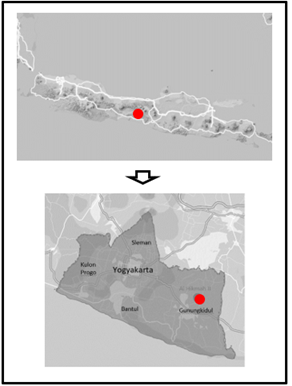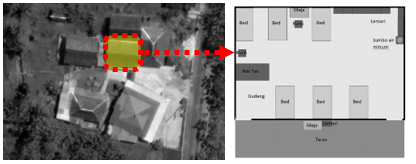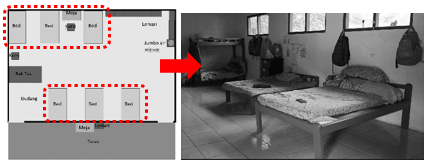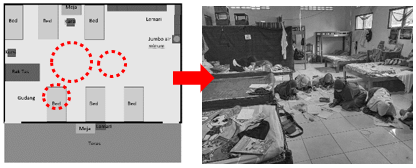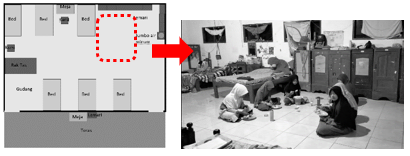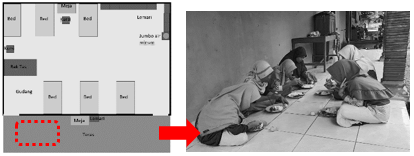Territory of Children’s Female Bedroom at Pesantren Al Hikmah II Yogyakarta, Indonesia
- Bakti Setiawan
- Ratna Dewi Nur’aini
- Syam Rachma Marcillia
- -165
- Feb 1, 2024
- Early Childhood Education
Territory of Children’s Female Bedroom at Pesantren Al Hikmah II Yogyakarta, Indonesia
Ratna Dewi Nur’aini1,2, Bakti Setiawan3*, Syam Rachma Marcillia3
1Student of Doctor Architecture, Universitas Gadjah Mada, Indonesia
2Department of Architecture, Universitas Muhammadiyah Jakarta, Indonesia
3Lecturer of Doctor Architecture, Universitas Gadjah Mada, Indonesia
*Corresponding Author
DOI: https://doi.org/10.51244/IJRSI.2024.1101013
Received: 19 December 2023; Accepted: 01 January 2024; Published: 31 January 2024
ABSTRACT
Pesantren is one of the places of choice for parents to educate their children with the hope that their children will one day get success in the world and the hereafter. but the age of children who tend to still depend on their parents will certainly regulate their behavior towards their environment to achieve their quality of life. The behavior of the territoriality of the child’s space in the boarding school is interesting to study how these children achieve their quality of life. The purpose of this research is to identify children’s behavior towards space settings, identify factors that form children’s space territoriality, and then find the concept of children’s space territoriality in pesantren in order to achieve quality of life. This research uses a qualitative descriptive method with a rationalistic approach. The scope of environmental and behavioral studies (EBS) research is about the relationship between human behavior and the environment. The results of the study show that the girls’ dormitory space area is included in the primary territory category because it is related to personal activities. Factors forming territoriality in a room are personal (personality, age, and gender), situational (physical order, time, distance, activity, rules, and comfort), and socio-cultural (rules, language, diversity of resident activities, and social sense).
Keywords: boarding school; pesantren; quality of life; spatial value; territory.
INTRODUCTION
Pesantren or often called boarding school is an educational institution based on Islamic values and is one of the characteristics of Indonesia. Pesantren were found in Indonesia since pre-colonial times which were established as a place of learning for santri who had aspirations as preachers of Islam in their home communities. And currently, pesantren are an important concern in the Indonesian education system that serves the wider community [1]. In addition to studying the Qur’an and Hadith, currently modern pesantren also act as general education institutions that are carried out in an integrated manner. As an independent private educational institution, the manager is more flexible in developing pesantren with their own characteristics. Pesantren is a place for santri activities where they carry out learning activities and carry out daily activities to be able to realize the efficiency of teaching and learning activities and social processes, so an adequate space is needed for these activities to take place.
In the past few decades, pesantren have experienced great growth in quantity. This development occurred in rural, suburban, and urban areas. This was revealed by Zayadi, director of pesantren at the Ministry of Religious Affairs. The number of pesantren increased by 224% and the increase in the number of students reached 261% [2]. The number of pesantren that have spread across the provinces in Indonesia currently reaches 27,722 pesantren with a total of 4,175,623 students. In the Special Region of Yogyakarta Province, there are 320 pesantren with 63,477 students. This shows that the government pays very high attention to the development of pesantren. According to statistical data, there are two categories of pesantren students in Indonesia, namely students who stay overnight (mukim) as much as 71% and do not stay overnight (non-mukim) as much as 29%. In addition, the type of pesantren can also be divided into two, namely pesantren that only teach the yellowclassical books (47%) and pesantren that combine yellowclassical and formal learning (53%) [3]. The level of diversity of pesantren types, orientation and independence of pesantren leaders raised the image of pesantren as an educational institution with private status but has independence and also gets support while serving the community (Zayadi in [2]).
Currently, boarding schools are starting to emerge that accept students of children’s age. Some parents who choose boarding schools as a place for their children’s education with the hope that their children will be successful in this world and in the hereafter, devoted to parents, and not easily discouraged in life, their children can develop into noble human beings to avoid the negative influence of the general community that is less controlled [4]. Children’s education is a fundamental education to achieve quality of life, which is influenced by environmental quality. Pesantren is one of the places of choice for parents for that education. On the other hand, according to a psychologist’s opinion that elementary school age is a time when children’s development of basic values is sharpened and still needs a foundation from parents, so according to him it is not appropriate to enter elementary school-age children into boarding schools [5]. The phenomenon of children in pesantren is very diverse, some immediately feel at home but some feel uncomfortable living in pesantren. According to Haedari, the director of the boarding school sector within the Ministry of Religious Affairs, he has encountered cases of children who have just entered boarding schools being traumatized due to differences between parenting patterns at home and in boarding schools [5]. However, some pesantren have applied less strict rules to child students and provided an adaptation period for children so that they feel comfortable living in pesantren. The government also intensified the program to optimize Islamic boarding schools as a place of childcare and a pioneer in preventing violence against children [6]. In addition, the government also created a child-friendly pesantren model in order to prevent violence against children in the pesantren environment [7].
Based on the description of the background above, this study aims to identify children’s behavior towards space settings, identify the factors forming the territoriality of the children’s room, and then find the concept of territoriality in the children’s room in Pesantrens in order to achieve quality of life.
LITERATURE REVIEW
A. Pesantren
Pesantren or often called boarding school is one of the first Islamic educational institutions established in Indonesia. The term pesantren is adopted from Sanskrit, namely from the word santra which consists of the words san (good person) and tra (helpful), so that santra is defined as a good and helpful person. According to Wahid (2001) in [8], pesantren is almost similar to military academy education, and also like a monastery which illustrates that people who study there will experience totality in their lives. Meanwhile, according to [9], there are thousands of Islamic educational institutions spread across Indonesia. Some of these Islamic educational institutions each have a designation according to the region, such as dayah and rangkang are designations in Aceh, the mention of surau in the West Sumatra area, and pondok pesantren is a mention in the Java Island area.
Pesantren on the island of Java have similarities with lodgings in a hermitage. The lodging is in the form of a simple house which is then partitioned into several rooms that function as dormitories for boarding students. [10] describes a boarding school, which is a building that functions as a cottage or dormitory for students used for living made of bamboo. Pesantren is defined as a place to live for students.
Some of the main things that every pesantren must have to obtain an operational license from the government are as follows [11]:
- Pesantren leader or Kyai. The designation for the leader of this pesantren varies according to the peculiarities of each region such as gurutta, tuan guru, anre gurutta, sheikh, inyiak, ustadz, or ajeungan. A kyai must have religious competence and good social skills because of his role as a figure, role model, and/or at the same time as a caregiver for students and stakeholders of his pesantren. The role of kyai is very important in the establishment and development of pesantren because he is the central figure in the pesantren. The character and success of a pesantren is highly dependent on the competence, charisma, authority and skills of its kyai.
- Resident santri. In the development of pesantren, santri are one of the key determinants because the first step in the stage of building a boarding school is that it must have students (santri) who are ready to study with the caregiver/ustadz in the pesantren. If the students have settled in the house of the teacher/ustadz who is an alim, then the teacher/ustadz can only be called a Kyai and can start providing more complete facilities for his boarding school. Santri/students consist of two categories, namely santri kalong and santri mukim. Santri kalong is part of the students who do not stay in the pesantren but return to their respective homes after completing a lesson at the pesantren. They usually come from areas around the pesantren so they don’t mind if they go home often. The meaning of santri mukim is those who live in boarding schools and usually come from distant areas.
- Dormitory or pondok as a place for students to live. In this cottage the students live together with the care and teaching of one or several teachers known as Kyai.
- Mosque or Mosques and Islamic education have a very close and inseparable relationship. In the context of pesantren, the mosque is considered the most appropriate place to educate students, especially in the practice of 5-time prayers, sermons, and Friday prayers, and the teaching of classical Islamic books [10]. Usually the first to be established by a kyai who wants to develop a mosque is a mosque located near or behind the kyai’s house.
- Study of the yellow Islamic classic books or the mu’allimin The yellow book refers to traditional books, while dirasah Islamiyah with the mu’allimin education pattern is a collection of Islamic studies that are arranged systematically and organized, integrative and comprehensive in nature which is often referred to as the madrasy system.
B. Territory
According to the Merriam Dictionary, the term territoriality is defined as a pattern of behavior related to the defense of a territory. According to [12], territoriality is defined as containing the boundary element of a living creature that affects the element of property rights over the area in which it is located. Control behavior is contained in it, which is carried out by each individual or by a group of individuals. This is done to defend against disturbances from outside the area. Meanwhile, according to [13], the term territory is related to the behavior of forming a controlled area. This is done to obtain optimization in privacy, namely by redesigning the area or by switching to another place. What is fundamental to the notion of territory is property rights, territorial arrangement and marking, personalization, rules or efforts to survive intervention, being able to meet both physical and psychological needs. Behaviors related to space are very diverse and that is what is called territoriality.
As a territory that is controlled and owned, territory is closely related to a community’s identity, for example the expression “what we have” and “what others have”. [13] categorizes territories in relation to the involvement of individuals, the proximity of individuals or groups of individuals in their lives, and the frequency of use.
- Primary territory is an area that is an important part of the user’s daily activities. This area is recognized by others as someone’s property that is used specifically and controlled.
- Secondary territories are areas that are not always used specifically by a person or group of people and are controlled periodically. This area is relatively large in scope.
- Public territory is an area where anyone can enter and use, but the rules that apply to the area must still be obeyed.
Territory types are distinguished by the size of the area covered by its users. The area is controlled by a person or group of people or covers a larger area with control exercised by the public or general public with imaginary boundaries. Public space can be used by a person or group of people or the general public by considering the level of interest of its users. Brower (1976) in [14] classifies territories as follows:
- Personal territory is territory that can be controlled by a person or group of people. Members of a group have a close relationship such as marriage or blood relations. An example of this type of territory is a house or bedroom. Control is freely exercised by a person and others will accept it as it is even though it seems to prioritize personal interests and there is no need for justification, consistency or prior notification as long as it does not lead to anti-social behavior. Property rights and power are protected by law and thus become very strong. Personal possessions have more private markings and the identity of the owner often marks the area such as posting family photos or certificates of appreciation. Strangers are rarely able to enter personal territory because the owner will be very cautious of strangers.
- Community territories are controlled by a group of people. Group members change frequently, but each group member is always screened and at certain times an event is held to induct new members. The inauguration ceremony is done to clearly distinguish between community members and outsiders. Community territory is claimed by members because each individual is involved in a spatial setting such as students when at school or someone praying in congregation at the mosque. However, all members must stay within the corridor of the purpose of the group of people and follow the rules or traditions within the community. Control of this type of territory is not freely carried out strictly because outsiders who enter this territory are not a nuisance as long as they do not violate the applicable rules and restrictions.
- Community territories are open to the public and controlled by the general public as well. Examples of community territories are public facilities such as performance spaces, waiting rooms, and others. Prohibitions and controls on this territory are not very free to do. Control of this territory is realized through norms and rules made by the community itself. Rules are applied by considering age differences, gender differences, or ethnic/racial differences. An example of the application of rules in the Middle East region is the rule of using the hijab / veil when in public areas. To recognize the territory of this community with the emergence of signs that are real, clear, and have standards.
- Free territories have inhabitants who are not permanent. In addition, one’s presence in this territory is free from controls and restrictions. Rules that direct behavior will be determined by the users themselves or depend on natural forces or based on moral norms. There are no territorial signs/symbols so control and rules will arise from the imagination and exploration of the inhabitants. Conditions can sometimes be pleasant, but sometimes make people feel scared. Examples of free territories are beaches and forests.
Territoriality is the limit at which living things can form territories and defend them from intruders [12]. Territoriality as something that connects a person or group of people with the surrounding environmental conditions, has a sense of ownership and control over its users. There are elements of defense and attachment [15]. Control is defined by [13] as a way of regulating boundaries by marking or personalization as a sign of ownership of a territory. Personalization is a sign of a person or group of people owning an area by giving rise to personal signs/symbols both physically in the form of placement and non-physically in the form of place attachment [16]. According to experts, some elements related to territoriality are boundaries, territory, survival, control, spatial behavior, ownership, intimacy, privacy, and exclusivity [17]. Territoriality is a condition of how the quality of territory is formed through interactions between individuals and between organizations, physical settings as a container for activities. As one of the elements of behavioral architecture, territoriality regulates the interaction between humans and the environment as a place of activity. Territoriality becomes a behavioral attribute whose quality can be measured.
Territory has diversity. The factors that influence the diversity of territories are personal, situational, and cultural.
- Personality strongly influences territoriality, such as personality, age, and gender,
- Different situations will affect territoriality. In shaping territoriality attitudes, physical and socio-cultural settings play a role.
- Culture affects territoriality. Diverse cultures cause differences in territoriality. For example, if someone visits a public space where the culture is much different, their territorial attitude will also be different.
METHODOLOGY
This research uses a qualitative descriptive method. A rationalistic approach was used in this research. Truth is seen not only from empirical experience but also based on thinking. According to the philosopher of science, all knowledge originates from intellectual thought formed from the ability to think logically [18]. Rationalistic research aims to generalize from empirical meaning. This research is exploratory in nature whose purpose is not to test theories but to find something, so in this research hypotheses are not needed [19]. The purpose of this research is to explore the characteristics of children’s spatial territoriality in boarding schools.
This research is a research in the field of environmental and behavioral studies (EBS), which is about the relationship between human behavior and the environment, which according to [20], this science emphasizes the relationship between architecture and its environment, be it physical, biotic, or social. The relationship between architecture and its environment is reciprocal based on certain norms to understand a phenomenon [21].
Studies in the field of environmental relationships and human behavior require empirical methods, to obtain data related to the context of everyday environments [22]. This also applies to research that focuses on children’s behavior, which is expected to be closely related to children’s daily areas and activities (Pellegrini, 1991 in [23]). Moreover, children have a different perspective from adults, both in the form of actions and responses to their environment (Bechtel et. Al. in [23].
This research focuses on the life space of children in pesantren which is researched in an explorative way in the field, which is based on the theoretical construction of the relationship between human behavior and its environment.
Pesantren Al Hikmah II is located at Branjang, Ngawis, Karangmojo, Gunungkidul, Yogyakarta, Indonesia.
Figure 1. Location of Pesantren Al Hikmah II
Source: (Google Maps, 2023)
The research began by looking at phenomena in the field, namely observing children’s daily activities in pesantren from waking up to going back to sleep. The phenomena found include: types of children’s activities, children’s activity space, and children’s activity time. This research is explorative about children’s space in pesantren. Children’s conditions are certainly different from adults. Differences are found in terms of cognitive development, social competence, autonomy, personal mobility, and physical size. Therefore, a special method is needed to obtain data and analyze it in research on children’s behavior in their environment, namely by field observation, supported by interviews and behavior mapping, which is then triangulated (Ziegler and Andrews, in [25]). Data collection in this study was carried out by means of observation to the pesantren, observing the behavior of elementary school-age students (7-12 years old) in daily activities and observing the spatial setting used to accommodate the behavior of these students. Interview techniques were conducted with several students, guardians of students and pesantren managers to support data validation. Behavioral mapping was conducted to observe the behavior of students in their activity settings and identify their territories. Behavioral mapping by means of place centered mapping and person centered mapping. Data collection also uses the physical traces method, which is a technique by looking at the physical environment that reflects previous activities. Humans will leave traces in every activity such as footprints and hand prints. Physical traces can also change human behavior towards their environment, for example when someone enters a new building they will behave differently from when they were in the previous building [26]. In addition, using the literature study method is done by reviewing references sourced from the internet, scientific journals, research reports (theses, theses, dissertations), books and other reading sources.
Observation is one of the methods to examine non-verbal behavior such as gestures, postures, and human behavior in certain settings. The stages of the observation technique according to [27] are:
- Casual observation. This observation was conducted to initiate research in the field and without special planning. At this stage, researchers obtained an initial description of the phenomena that occurred in the field so that the selected pesantren was suitable to be the research locus.
- Systematic observation. This observation is an advanced stage of casual observation, the categories for data collection have been prepared in detail. At this stage, it uses the theoretical construction obtained from the literature review which functions to direct data collection in the field which is adjusted to the research objectives.
- Participatory observation. In this observation, the researcher actively participates as the object of research. This participatory observation is needed to eliminate the distance between the object under study and the researcher, so that it can be well understood the conditions that will be extracted for research purposes [20]. In this study, the main object of observation is the behavior of children in pesantren, so researchers live in pesantren for a certain period of time to make direct observations for 24 hours. By mingling with the object of research, it is expected to be more familiar and understand the results of the research more deeply.
According to [27], behavioral mapping is a depiction through a sketch on an area where humans carry out activities. This method aims to describe behavior on a map, identify the type of behavior and its frequency, and find the relationship between behavior and the space used. Behavioral mapping methods used in this study is place-centered mapping. This method is used to observe the behavior of children either individually or in groups in certain spatial settings in certain situations and over a period of time. Observations are made repeatedly to find out the behavior patterns that occur in the space.
Interview is a data collection technique that deals with human attitudes, experiences, hopes, and ideals as expressed by respondents answering researchers’ questions [28]. Interviews are the main assistant in the observation method, as explained by [29] that interviews can be conducted when an observation research has not obtained the desired results. Interviews also aim to obtain data in the form of experiences or activities that are not generally seen in an object of observation.
According to [30], data triangulation aims to connect (crosscheck) various data collection techniques that have been carried out with the same source. In this study, data triangulation was carried out obtained from the results of field observations, behavioral mapping, physical traces, and interviews with the object of research, namely child students at boarding schools.
The analysis process was carried out by formulating units of information or themes of findings from each case, then categorizing all cases to find trends as factors that determine the formation of spatial territoriality and interpretation of the realization of the characteristics of spatial territoriality in children’s pesantren. The analysis used an inductive method and then deductive analysis, then synchronized the findings and interpreted them as research findings about children’s space territoriality in pesantren.
RESULTS AND DISCUSSION
Pesantren Al Hikmah II was established in July 2008 by Drs. KH. Supomo. The establishment of this pesantren began with the founder’s concern about the condition of community education around the pesantren. At the time of its establishment, education in this hamlet was not a priority due to limited economic conditions, this was indicated by the high dropout rate of children around the pesantren [31]. This pesantren is located in Branjang Hamlet, Ngawis Village, Karangmojo District, Gunungkidul Regency, Yogyakarta Special Region Province.
Currently, there are 27 elementary school-aged students (between 6-12 years old), consisting of 21 male students and 6 female students with details in Table IV 1. All students reside in the boarding school, they attend SD Muhammadiyah Branjang which is 170m away from the boarding school to the north. There are a total of 7 caregivers/teachers, and 2 of them live in the boarding school. All students stay at the boarding school and are allowed to return home during school vacations.
Pesantren Al Hikmah II is located in a rural environment, the distance between the boarding school and residential areas is about 50m. The hamlet road is made of partly concrete cast material, combined with soil and stones. Empty land around people’s houses is used as rain-fed rice fields, some are planted with teak trees. The educational facility in Branjang Hamlet is SD Muhammadiyah Branjang, which is about 170m away from Al Hikmah II Islamic boarding school. The boarding school leader/kyai’s house is about 200m from the location of pesantren.
The buildings being erected at the Pesantren Al Hikmah II currently include: prayer room, multi-purpose room, boys’ dormitory, girls’ dormitory, classrooms, caretaker’s room, office, gazebo, kitchen and toilets. The children’s play yard is outdoor at the front, center and back.
The room or space that is often used for activities by students is a prayer room measuring 10 x 14 m2 and oriented towards the Qibla. The rooms in the prayer room include: main prayer room, foyer, mihrab, sound system room, ablution area, toilet and storage. The male dormitory measures 6 x 9 m2 and contains 11 double-decker beds and 21 cupboards for storing students’ belongings. There is a terrace at the front of the hostel. The female dormitory measures 6 x 9 m2 which contains 6 beds and 6 cupboards to store the girls’ belongings. There is a terrace at the front of the hostel. Apart from that, there is a multi-purpose room, classroom, gazebo, office, caretaker’s room, kitchen and toilet.
A. Design Evaluation on Spatial Layout
There are many variations of space users in utilizing space in pesantren, both in the form of formal and non-formal behavior.
Figure 2. Lay Out of the female bedroom unit
Source: Drawn by the Author, 2023
The girls’ dormitory is 6 x 9 m2 which contains 6 beds and 6 cupboards to store the girls’ belongings. There is a terrace in front of the dormitory. Each female santri is occupied by a single non-bedded bed with a size of 200 cm x 90 cm. The description of activities and various behaviors in the bedroom setting is described as follows:
Figure 3. Lay Out the bed
Source: Drawn by the Author, 2023
In accordance with the main function of the dormitory sleeping room is used as a resting room which is done regularly every night until the morning. However, there are also some students who after school take a nap until Asr time, but there are also some who do not take a nap. The students sleep in their own beds with a total of 6 single beds according to the number of dormitory residents. Figure 3 shows the layout of the sleeping quarters in the girls’ dormitory room.
Figure 4. Lay Out of Shared Space for Studying
Source: Drawn by the Author, 2023
The girls’ dormitory bedrooms are not only used for resting but also for doing schoolwork, they do schoolwork individually or together. Because the number of study tables has not been fulfilled, the students study on the floor, and some do their assignments in bed. They write without a desk with a bent body position, this certainly reduces physical comfort. Figure 4 shows the position of the common space between the beds.
Figure 5. Lay Out of Shared Space for Eating
Source: Drawn by the Author, 2023
Pondok Pesantren Al Hikmah II does not have a dining room, therefore the students usually use the bedroom area as a dining room together by sitting on the floor facing each other. The shared dining area in the bedroom is shown in Figure 5.
Figure 6. Lay Out of Shared Space at Terrace
Source: Drawn by the Author, 2023
In addition to eating in the sleeping room, the students also often use areas that are adequate for eating together, namely the room in the dormitory and the dormitory terrace. Figure 6 shows the position of the room used as a place to eat together.
The explanation of the division of space for activities in the female santri bedroom according to Altman (1975) is included in the primary territory, namely the area around the bed and closet where each of their belongings are stored. Because based on Altman’s theory, primary territory is an area that is an important part of its users in carrying out daily activities. This area is realized by others to be someone’s property that is used specifically and controlled. Children’s territory behavior in the girls’ dormitory is different from the boys’ dormitory. This is because female students pay more attention to the cleanliness and tidiness of their beds than male students. In addition, it is also influenced by the number of male students who are three times more than female students in the same space size setting, namely 6×9 m², so that the bed layout is also different. Girls’ beds are not arranged, while boys’ beds are arranged.
Factors that shape or influence the diversity of territories are personal, situational, and socio-cultural. Personal factors are very influential on territoriality, such as personality, age, and gender. This personal factor was also found in the pesantren where this research was conducted. The nature or personality of santri varies, such as timid, quiet, brave, rebellious, obedient, polite, cooperative, ignorant and friendly, which will certainly affect their behavior in pesantren. In addition, age and gender also affect some territorial behaviors. Different situations will affect territoriality. In shaping territoriality attitudes, physical and socio-cultural settings play a role. Culture affects territoriality. At Al Hikmah II Islamic boarding school, there is no dining room available, therefore the students use an area that is sufficient for eating together, namely the room in the dormitory and the dormitory terrace.
B. Layout Concept and Space Perspective
Factors that cause comfort in the dormitory room space are sometimes less considered such as the number of users that do not match the capacity of the room area, furniture layout, furniture design, room conditions including lighting and ventilation, and design value. The design achievement for the dormitory room is in accordance with its manners, namely responsibility, mutual respect and respect, discipline, and maintaining cleanliness. The design application can be seen in the room layout which divides the area based on its function, namely the sleeping area, study area, and storage area. With the division of this area, students will be accustomed to discipline in carrying out their activities.
CONCLUSION
From the discussion of activities and the division of space in the girls’ dormitory, it can be concluded that spatial qualities are identified as views, spatial arrangements, transitions between public and private spaces or privacy, what is perceived, built, and the density of people/number of residents occupying the space. Factors forming territoriality in a space are personal (personality, age, and gender), situational (physical setting, time, distance, activity, rules, and comfort), and socio-cultural (rules, language, diversity of resident activities, and social sense).
The women’s dormitory room area is included in the primary territory category because it is related to personal activities. This is because in the dormitory room the main activities are a place to rest, study, and a place to store personal items. This area is realized by others to be someone’s property that is used specifically and controlled. Children’s territory behavior in the girls’ dormitory is different from the boys’ dormitory, proving that the primary territory is influenced by the type of activity, gender, number of space users, space size, and furniture settings.
ACKNOWLEDGMENT
Thank you to all those who have assisted in the completion of this research.
REFERENCES
- M. F. Isbah, “Pesantren in The Changing Indonesian Context: History and Current Developments,” Qudus Int. J. Islam. Stud., vol. 8, no. 1, pp. 65–106, 2020.
- Muhyiddin, “Pertumbuhan Pesantren di Indonesia Dinilai Menakjubkan,” Republika.co.id, 2017. [Online]. Available: https://www.republika.co.id/berita/dunia-islam/islam-nusantara/17/11/30/p088lk396-pertumbuhan-pesantren-di-indonesia-dinilai-menakjubkan. [Accessed: 18-Jan-2021].
- ditpdpontren.kemenag.go.id, “Statistik Pesantren,” 2021. [Online]. Available: https://ditpdpontren.kemenag.go.id/pdpp. [Accessed: 18-Jan-2021].
- M. Mulyanah, E. Sumarna, and E. Firdaus, “Pola Pembinaan Program Pesantren Anak Usia Dini Pada Pondok Pesantren Nurul Barokah,” TARBAWY, vol. 2, no. 2, pp. 104–114, 2015.
- A. N. Aminah, “Usia Berapa Sebaiknya Anak Mondok di Pesantren?,” Republika.co.id, 2017. [Online]. Available: https://republika.co.id/berita/ok0eya384/usia-berapa-sebaiknya-anak-emmondokem-di-pesantren. [Accessed: 18-Jan-2021].
- A. Mansur, “Pesantren Didorong Jadi Pelopor Pencegah Kekerasan Anak,” Republika.co.id, 2020. [Online]. Available: https://republika.co.id/berita/q6n6sj366/pesantren-didorong-jadi-pelopor-pencegah-kekerasan-anak. [Accessed: 18-Jan-2021].
- A. Kurniala, “Bentuk Model Pesantren Ramah Anak, Seperti Apa?,” Republika.co.id, 2019. [Online]. Available: https://republika.co.id/berita/q08790349/dunia-islam/islam-nusantara/19/10/31/q07srm313-bentuk-model-pesantren-ramah-anak-seperti-apa. [Accessed: 18-Jan-2021].
- S. Ngabekti, “Konsep Pendidikan Untuk Pembangunan Berkelanjutan (Kasus Pondok Pesantren Modern Selamat Kendal),” Universitas Gadjah Mada, 2013.
- A. Azra, Pendidikan Islam: Tradisi dan Modernisasi Menuju Milenium Baru. Jakarta: Penerbit Kalimah, 2001.
- Z. Dhofir, Tradisi Pesantren: Studi Pandangan Hidup Kiai dan Visinya Mengenai Masa Depan Indonesia. Jakarta: LP3ES, 2011.
- Direktur Jenderal Pendidikan Islam, Petunjuk Teknis Izin Opearsional Pondok Pesantren. 2018.
- J. D. Porteous, Environment and Behavior. England: Addison Wesley Publishing, 1977.
- Altman, The Environment and Social Behavior: Privacy, Personal Space, Territory, and Crowding. Monterey, California: Cole Publishing Company, 1975.
- F. Zubaidi, “Territoriality in the Traditional Context,” Psychol. Behav. Sci., vol. 2, no. 3, p. 89, 2013.
- B. B. Brown and I. Altman, “Territoriality, Defensible Space and Residential Burglary: An Environmental Analysis,” J. Environ. Psychol., vol. 3, no. 3, pp. 203–220, 1983.
- S. N. Brower, Territory in Urban Settings. NY and London: Plenary Press, 1976.
- R. D. Nur’aini, “Teritorialitas Dalam Tinjauan Ilmu Arsitektur,” Inf. dan Ekspose Has. Ris. Tek. SIpil dan Arsit., vol. 15, no. 1, pp. 12–22, 2019.
- N. Muhadjir, Metodologi Penelitian Kualitatif. Yogyakarta: Penerbit Rake Sarasin, 1996.
- A. Djunaedi, Metodologi Penelitian. Yogyakarta: Pascasarjana UGM, 2000.
- Haryadi and B. Setiawan, Arsitektur Lingkungan dan Perilaku. Yogyakarta: Gadjah Mada University Press., 2010.
- A. Rapoport, Human Aspects of Urban Form: Toward a Man-Environment Approach to Urban Form and Design. Oxford: Pergamon Press, 1977.
- R. G. Barker, Ecological Psychology: Concepts and Methods for Studying the Environment of Human Behavior. Stanford University Press, 1968.
- Sativa, “Ruang Sosial Anak di Kampung Padat Kota,” Universitas Gadjah Mada, 2018.
- Google Maps – Al Hikmah II, “Pondok Pesantren Al Hikmah II Branjang – Google Maps,” 2023. [Online]. Available: https://www.google.com/maps/place/Pondok+Pesantren+Al+Hikmah+II+Branjang/@-7.8689745 ,110.2646875,9.9z/data=!4m5!3m4!1s0x2e7a4adbbb2eccef:0xa04c86d7149b3601!8m2!3d-7.9315661!4d110.6729011!5m1!1e2. [Accessed: 10-Jun-2022].
- R. Bechtel, R. Marans, and W. Michelson, Methods in Environmental and Behavioral Research. New York: Van Nostrand Reinhold Company Inc, 1987.
- J. Zeisel, Inquiry by Design: Tools for Environment-Behavior Research. New York: Cambridge University Press, 1981.
- R. Sommer and B. Sommer, A Practical Guide To Behavioral Research. New York: Oxford University Press, 1980.
- J. Vredenbregt, Metode dan Teknik Penelitian Masyarakat. Jakarta: Gramedia, 1983.
- Koentjaraningrat, Metode-Metode Penelitian Masyarakat. Jakarta: Gramedia, 1976.
- Sugiyono, Metode Penelitian Kombinasi (Mixed Methods). Bandung: Alfabeta, 2012.
- E. Firmansyah, H. G. Mawandha, and M. P. Bimantio, “Pesantren Mandiri Pangan, Program Pelatihan Optimasi Pemanfaatan Lahan Kritis Berbasis Pertanian Terpadu di Pondok Pesantren Al-Hikmah Gunungkidul,” JMM (Jurnal Masy. Mandiri), vol. 4, no. 5, pp. 797–805, Nov. 2020.


